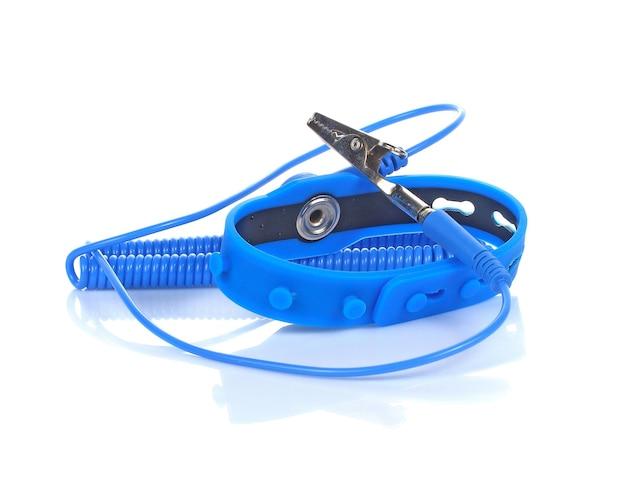Electrostatic discharge (ESD) can cause serious damage to delicate electronic components, making them malfunction or even fail completely. As technology becomes an integral part of our daily lives, it’s crucial to take precautions to protect our devices from static electricity. One effective solution is using an anti-static wrist strap, designed to ground any static charge your body may carry.
But what if you’re in a pinch and don’t have access to a ready-made wrist strap? Fear not! In this blog post, we’ll walk you through the process of creating your very own DIY anti-static wrist strap. From understanding the science behind static electricity to using readily available materials, we’ll guide you step by step. So, let’s dive in and learn how to stay shock-free while handling electronic devices!
How to DIY an Anti-Static Wrist Strap
So, you’re ready to dive into the exciting world of DIY electronics. But before you start tinkering with those delicate components, there’s something important you need to know about: static electricity. It’s like that clingy ex – you don’t want it ruining your day or your perfectly functioning circuit board. That’s where an anti-static wrist strap comes to the rescue!
Understanding the shocking world of static electricity
Before we get our DIY on, let’s have a quick crash course on static electricity. Picture this: you’re about to touch a metal object, and suddenly, ZAP! That unexpected shock is caused by an imbalance of electric charges on the surface of your skin. And guess what? Those tiny jolts can do serious damage to sensitive electronic components.
What makes an anti-static wrist strap so special
You might be wondering, “Why can’t I just wear rubber gloves or go barefoot?” Well, my friend, an anti-static wrist strap is specially designed to keep your electric potential in check. It’s like a knight in shining armor, protecting your precious gadgets from those sneaky static shocks.
Making your very own anti-static wrist strap
Now that we’ve established the importance of an anti-static wrist strap, it’s time to put your DIY skills to the test. Here’s a simple step-by-step guide on how to make one from scratch using easily accessible materials around your home:
Step 1: Channel your inner MacGyver
Grab a stretchy fabric headband that you’re willing to part ways with – the kind that keeps your hair in check during intense DIY sessions or when you’re rocking out to your favorite tunes. We’re repurposing it, so make sure it’s clean and free from any embarrassing stains.
Step 2: Embrace the power of metal
Locate a paper clip from your office supplies stash or, better yet, one that’s been hiding out in the abyss of your junk drawer. Unbend the paper clip to create a “U” shape.
Step 3: Bring it all together
Attach one end of the paper clip to the inside of the headband near the front, ensuring a secure connection. You can use strong adhesive or some handy duct tape to keep things in place.
Step 4: Strap it on, superhero style
Put the headband on your wrist, ensuring that the metal end of the paper clip is touching your skin. And voila! You’re now armed with a DIY anti-static wrist strap that even Superman would envy.
Safety precautions to keep in mind
Before you embark on your electronics adventure, let’s take a moment to discuss safety. While your trusty DIY anti-static wrist strap will help protect against most static electricity, it’s essential to follow these precautions:
1. Beware of the dark side
Avoid working in carpeted areas or wearing clothes made of synthetic fibers, as they can generate more static electricity than a balloon at a children’s birthday party.
2. Keep it grounded
Make sure your DIY wrist strap is properly grounded. You can achieve this by connecting the other end of the paper clip to a grounded metal object. Remember, we’re here to prevent static shocks, not create a sparkly, electrifying fashion statement.
3. Treat your circuit board like royalty
Always handle electronic components with care, using the anti-static wrist strap as an added layer of defense against static electricity. Your circuit board will thank you for it!
There you have it – your very own anti-static wrist strap, ready to shield your electronic creations from the wrath of static electricity. Now, go forth and conquer the world of DIY electronics with confidence, knowing that you’re protected like a tech-savvy superhero. Keep those static shocks at bay and let the sparks fly in all the right ways!
Frequently Asked Questions: DIYing an Anti-Static Wrist Strap
What is anti-static material
Anti-static material is a type of material that is designed to prevent the buildup and discharge of static electricity. It is made using a blend of conductive fibers or coatings that help to dissipate static charges, keeping objects and people safe from potential damage or shocks.
What can you touch to ground yourself
To ground yourself and discharge any static electricity safely, you can touch various grounded objects such as metal pipes, faucets, or even a properly grounded metal case of an appliance. These objects provide a pathway for the static charge to flow into the ground.
Can you ground yourself with stainless steel
While stainless steel does conduct electricity, its conductivity may not be sufficient to effectively ground yourself. It’s always best to rely on dedicated grounding methods, such as using an anti-static wrist strap, to ensure a reliable and consistent connection to ground.
How do I ground myself to avoid static shocks
To ground yourself and prevent static shocks, you can follow these steps:
1. Wear an anti-static wrist strap connected to a grounding point.
2. Touch a grounded object, like a metal water pipe or appliance casing, to release any static charge.
3. Avoid walking on carpets and synthetic materials that can contribute to static buildup.
How does a grounding wrist strap work
An anti-static wrist strap works by creating a direct, low-resistance pathway between your body and a grounded object. The strap is typically worn on your wrist and connects to a metal plate or alligator clip, which is then connected to a reliable ground source like an electrical outlet or grounding mat. This allows any static charge on your body to be safely discharged.
Does touching anything metal ground you
Not necessarily. While some metal objects can be grounded, not all metal objects are reliably connected to the ground. It’s important to choose specific grounded objects or use dedicated grounding methods, like an anti-static wrist strap, to ensure a proper pathway for static charge dissipation.
How do you ground yourself inside
To ground yourself indoors, you can:
1. Wear an anti-static wrist strap connected to a reliable ground source.
2. Touch a grounded metal object, such as pipes or appliance casings.
3. Use grounding mats or pads designed for static dissipation.
How do you ground yourself with electricity
When working with electricity, it’s essential to prioritize safety. To ground yourself properly, follow these steps:
1. Turn off the power source.
2. Use a grounding wrist strap connected to a reliable ground source.
3. Verify that the grounding connection is secure before proceeding with any electrical work.
Do I really need an anti-static wrist strap
While using an anti-static wrist strap is highly recommended, it may not be necessary for all situations. However, if you frequently work with electronic devices or components that are sensitive to static electricity, using a wrist strap provides an extra layer of protection to prevent damage.
Is stainless steel anti-static
Stainless steel itself is not inherently anti-static. However, depending on the specific grade and surface conditions, it may have some anti-static properties. Nonetheless, it’s always safer to rely on dedicated anti-static materials, such as those used in anti-static wrist straps, to ensure proper static dissipation.
How do you make an anti-static mat
To make an anti-static mat, you can use conductive materials such as carbon-infused rubber sheets or specialized anti-static matting available in the market. Alternatively, you can create a DIY anti-static mat by using a layer of conductive fabric or foil placed on a non-conductive surface like rubber or wood.
What can I use if I don’t have an anti-static band
If you don’t have an anti-static wrist strap, you can use alternative grounding methods like:
– Touching a grounded metal object before handling sensitive equipment.
– Working on a grounded anti-static mat or surface.
– Wearing grounded shoes or standing on an ESD mat to dissipate static charges.
What are anti-static wrist straps made of
Anti-static wrist straps are typically made with a combination of materials, including a flexible and adjustable band, conductive fibers or threads, and a metal plate or alligator clip for connection to a ground source. These components ensure secure and effective grounding while providing comfort during use.
How do you ground yourself when working on a laptop
When working on a laptop, you can ground yourself by following these steps:
1. Shut down the laptop and unplug it from the power source.
2. Wear an anti-static wrist strap connected to a reliable ground source.
3. Touch a grounded metal object before handling any internal components or making connections.
How can you prevent ESD without a wrist strap
If you don’t have access to an anti-static wrist strap, you can prevent electrostatic discharge (ESD) by:
– Touching grounded metal objects regularly to dissipate static charges.
– Using anti-static mats or work surfaces.
– Wearing grounded shoes or standing on an ESD mat.
– Ensuring a humidity level of around 40-60% as dry air increases the risk of ESD.
What is anti-static wrist wrap
An anti-static wrist wrap is another term used for an anti-static wrist strap. It is a device that you wear around your wrist to safely discharge static electricity and prevent potential damage to sensitive electronics or components.
Where do you attach a static wrist strap
To attach a static wrist strap properly, follow these steps:
1. Adjust the strap for a secure and comfortable fit around your wrist.
2. Connect the snap or alligator clip to the metal plate located on the strap.
3. Attach the other end of the wrist strap, typically equipped with an alligator clip, to a reliable grounding point such as an electrical outlet’s grounding pin or a grounding mat.
What is a grounding strap
A grounding strap, often referred to as an anti-static wrist strap or grounding wrist strap, is a device designed to prevent the buildup and discharge of static electricity. It creates a direct pathway between your body and a grounded source, allowing static charges to flow safely away.
How do you discharge yourself
To discharge yourself and eliminate any static charge safely:
1. Touch a grounded metal object, such as a water pipe or appliance casing.
2. Keeping contact with the object, slowly move your hand along it to allow the charge to dissipate gradually.
3. Avoid abrupt movements or direct contact with sensitive electronic components to prevent potential damage.

